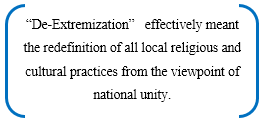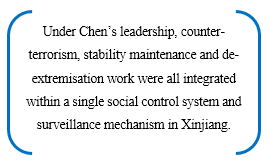Amb. Vijay Nambiar, Honorary Fellow, ICS, former Indian Ambassador to China, and Chef de Cabinet to United Nations Secretary General

For many scholars of history, the rule of Qing dynasty over Tibet, Mongolia and Xinjiang did not differ in principle from the European colonial penetration of Asia and Africa. Indeed, Manchu territorial expansion to the north, west and south of China proper was described, in magnitude, as one of the largest territorial expansions in 17th and 18th century world history.
Though the declared aim of the imperial rulers then was to “educate” the Uyghurs without changing their customs, religion, moral principles, food, clothing or language, the induction of Han administrators and the steady policy of population transfers encouraged during Qing times, led inexorably, by the end of the 19th century, to a consolidation of Manchu sovereignty and Xinjiang was turned into a province of China in 1884 bringing it under the Qing junxianzhi or Confucian-trained magistracy.
In the post-1911 (Xinhai revolution) period, Chinese leaders like Sun Yat-sen used the rhetoric of the unity of the “five peoples” [wuzu]—Manchu, Mongol, Han, Muslim, and Tibetan’ —to bring the territory under republican control. During the 1950s, under the PRC, quasi-military Han settlements called Production and Construction Corps were established in northern Xinjiang to exploit the agricultural and mineral resources and to populate the region. Han migration and settlement in Xinjiang continued over the decades and today the Han population in Xinjiang is over 40% as compared to 46% Uighurs.

Comprising one sixth of the country’s landmass, Xinjiang has abounded in natural resources, and provided China connectivity with Eurasia. While the region has faced stability challenges throughout its history, it was since the breakaway of the Central Asian republics from the USSR in 1992 that Beijing began, particularly, to see Xinjiang’s integration as a strategic and economic imperative for advancing its overall position in Central Asia.
For outsiders, the Xinjiang problem is a manifestation of identity politics, marked by the ethno-national resurgence of the Uyghur population. This has stemmed from a prolonged history of interethnic tensions, discrimination and prejudice that have defined the policies of the Chinese state combined with other elements such as Han supremacism, the suppression of protest or dissent, as well as the repression of all forms of Islamic practice and local culture in the region.
Within China, however, the troubles in Xinjiang are portrayed against the backdrop of the “three evil forces” (san gu shili) namely, religious extremism, ethnic separatism and terrorism, which have been the major source of internal security challenges in Xinjiang. The Chinese official media has persistently viewed Uyghur political activities through the single prism of their ethno-religious identity. Viewed as a “biological threat”, “a virus” in Chinese society that had to be eliminated, Uyghur identity was consistently projected in binary terms and its affiliation towards Islam was seen as a symptom of the “extremization” of the community and a threat to the national security of China. At the same time the Chinese state, its academics and media have constantly underlined the “sinister designs” of external terrorist organizations and the “anti-China” designs of some foreign countries.

While Hu Jintao’s focus was primarily economic development-oriented, his dictum being that functioning markets, water, electricity and heating were as much part of counter-insurgency operations as “police work and brute force,” with Xi Jinping’s accession to power, a novel approach to governance was adopted in Xinjiang in the light of what was called “new circumstances”. The new focus was firmly on advancing “social stability and permanent order” and the modernization of the Xinjiang governance system and capacity. This shift occurred primarily in the context of Xinjiang’s increased geopolitical importance in China’s neighborhood diplomacy in Central, South, and West Asia. The two main priorities of governance were to advance “ethnic unity” and promote “de-extremization”. Ethnic unity was defined as inter-ethnic relations based on parameters defined by the Party Centre. It stressed patriotism and the subordination of local identity to the larger national purpose determined by Beijing. “De-extremization” effectively meant the redefinition of all local religious and cultural practices from the viewpoint of national unity. It involved the regulation of Uyghur values, beliefs, and loyalties including adoption of dress, appearance and behavior as well as social campaigns, community events, and visual propaganda in public spaces in a manner that was instrumental to the consolidation of political stability.
The author of Countering Internal Security Challenges in Xinjiang: Rise of Surveillance State? explains that two different trajectories were successively followed in Xinjiang by two senior party officials in the period immediately before and during the Xi Jinping era. Initially, under Zhang Chunxian, Xinjiang’s official policy of fighting extremism, violent separatism, and terrorism was pursued with great nuance by delinking religion and ethnicity from extremist ideas. Zhang mingled with people from all walks of life and brought a balanced approach by emphasising improved conditions of the people’s livelihood and by scaling down of the rhetoric of the campaign against separatism and terrorism.

However, the violent attacks inside the region and other parts of China between 2013 and 2014, and especially during Xi Jinping’s visit to Xinjiang in April 2014 changed all that. In May 2014, Zhang Chunxian, himself in a People’s Daily article called for a “people’s war on terror” and for social stability, in which he declared that terrorists should be “chased down the streets like rats”. This is hardly the kind of speech that would come from a moderate. In fact, though he was speaking of “terrorists”, his use of dehumanizing references is extremely revealing considering that around the world such references had invariably been used in instances where very grave crimes against humanity had subsequently taken place. Late in May 2014, the party held the famous Second Central Xinjiang Work Forum (XJWF-II) where all seven Politburo Standing Committee members attended and which signaled the new priority attached to Xinjiang by the leadership.
With the replacement of Zhang Chunxian in August 2016 by a confirmed hardliner Chen Quanguo, it was clear that the central leadership had decided to abandon any kind of moderation in dealing with the troubles of this Muslim-dominated region. Under Chen’s leadership, counter-terrorism, stability maintenance and de-extremisation work were all integrated within a single social control system and surveillance mechanism in Xinjiang. Stern steps were also taken against all elements suspected of providing support to such forces or working against the interest of the state. A whole range of surveillance measures were adopted including physical, electronic, digital and biological surveillance, the setting up of extra-judicial detention camps as well as measures to crackdown on irregular groups mobilising any kind of local religious or cultural symbols and even targeting Uyghur pride.
Meanwhile, Xi Jinping also began to unveil his ambition of an Economic Belt linking China with the rest of Eurasia and Europe along with a Maritime Silk Road linking China through the South China Sea and the Indian Ocean all the way to the West, Xinjiang was to become the very fulcrum of this ambitious initiative. As the main gateway to Central and West Asian as well as European markets through the land, Xinjiang could emerge as a major growth centre in Western China. The plan was to develop the region into a major logistic centre under the Initiative with a railway network in Kashgar connecting eventually to South Asia.

Crucially underpinning such a grandiose vision for the region was the assumption that a secular culture could be nurtured in this region characterized by urbanization, consumerism, education and modern communication. Such a culture, it was assumed, would replace the outmoded religious and ethnic values of the local population of Xinjiang. The new phase of economic development and integration under the Belt Road Initiative (BRI) in Xinjiang was seen as an opportunity to raise the conditions of the local population to a higher level, while, at the same time, establishing the success of the Party’s national and social security policies in Xinjiang.
But things do not seem to be panning out in this manner. Rather Xinjiang is increasingly becoming the flashpoint of political confrontation between China and the Western powers. On the one hand, a rising China is showing off its economic successes and rise as exemplifying a new model of leadership to the world, one characterised by what Professor Yan Xuetong calls “humane authority” or “Wangdao” (kingly way) of governance, in contradistinction to what he calls the “hegemonic authority” or “Badao” of the “liberal democracies” of the West. But this is belied by the ruthless Chinese policies of detention, forced labour, forced sterilization of women of the minority Uyghur community and Han majoritarian assimilitionism inside Xinjiang.
This has produced a major international backlash, arousing condemnation of China, with calls in the UN Human Rights Council and elsewhere for China to be more accountable, for it to formally adhere to the ILO Convention against Forced Labour and for punitive measures against it including cancellation of the recently concluded investment agreement with the EU, boycott of the 2022 Winter Olympics etc.
China’s official response to such charges has, predictably, been to describe them as part of a “deliberate smear” campaign, a sign of anti-China bias and illustrative of the obsolete mentality of ideological confrontation of the Cold War.
Within Xinjiang, however, it is still unclear if the state’s growing determination to control Uyghur minds, to police Uyghur society, and to reorient popular Uyghur attitudes will succeed in bringing local sentiment closer toward Beijing. The present indications, at least are not very promising.
This blog piece is based on the opening remarks by Amb. Nambiar as Chair for ICS webinar on ‘Xinjiang in the Xi Era’ held on 14 April, 2021.